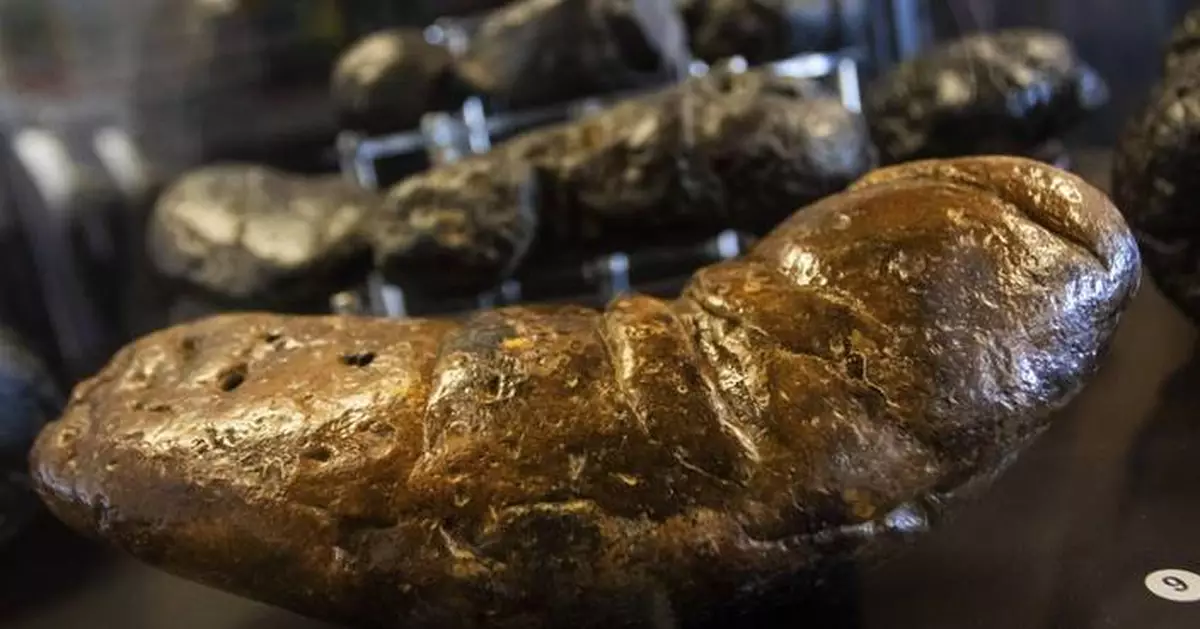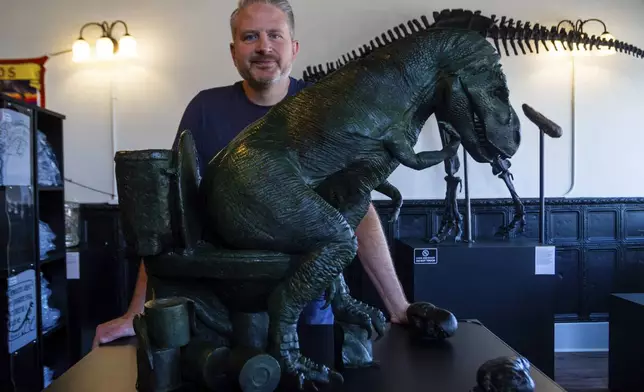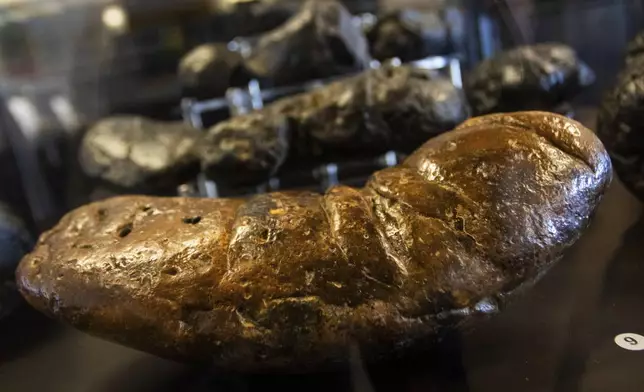WILLIAMS, Ariz. (AP) — One way to help tell how a Tyrannosaurus rex digested food is to look at its poop.
Bone fragments in a piece of fossilized excrement at a new museum in northern Arizona — aptly called the Poozeum — are among the tinier bits of evidence that indicate T. rex wasn’t much of a chewer, but rather swallowed whole chunks of prey.
Click to Gallery
WILLIAMS, Ariz. (AP) — One way to help tell how a Tyrannosaurus rex digested food is to look at its poop.
A fossilized coprolite in a casting at the "Poozeum" is shown, Friday, June 7, 2024 in Williams, Ariz. The museum in northern Arizona along Route 66 features the fossilized feces of prehistoric animals. Frandsen has been collecting the fossils known as coprolites for nearly three decades. His museum features roughly 7,000 fossils, including one suspected to be from a Tyrannosaurus rex. Frandsen holds two Guinness Book of World Records titles for parts of his collection. (AP Photo/Ty ONeil)
President and curator George Frandsen stands for a photograph inside his "Poozeum", Friday, June 7, 2024 in Williams, Ariz. The museum in northern Arizona along Route 66 features the fossilized feces of prehistoric animals. Frandsen has been collecting the fossils known as coprolites for nearly three decades. His museum features roughly 7,000 fossils, including one suspected to be from a Tyrannosaurus rex. Frandsen holds two Guinness Book of World Records titles for parts of his collection. (AP Photo/Ty ONeil)
President and curator George Frandsen stands for a photograph inside his "Poozeum", Friday, June 7, 2024 in Williams, Ariz. The museum in northern Arizona along Route 66 features the fossilized feces of prehistoric animals. Frandsen has been collecting the fossils known as coprolites for nearly three decades. His museum features roughly 7,000 fossils, including one suspected to be from a Tyrannosaurus rex. (AP Photo/Ty ONeil)
Fossilized crocodilian excrement is displayed at the "Poozeum", Friday, June 7, 2024, in Williams, Ariz. The museum in northern Arizona along Route 66 features the fossilized feces of prehistoric animals. Frandsen has been collecting the fossils known as coprolites for nearly three decades. His museum features roughly 7,000 fossils, including one suspected to be from a Tyrannosaurus rex. (AP Photo/Ty ONeil)
The sample is one of more than 7,000 on display at the museum that opened in May in Williams, a town known for its Wild West shows along Route 66, wildlife attractions and a railway to Grand Canyon National Park.
The Poozeum sign features a bright green T. rex cartoon character sitting on a toilet to grab attention from the buzzing neon lights and muffled 1950s music emanating from other businesses.
Inside, display cases filled with coprolites — fossilized feces from animals that lived millions of years ago — line the walls. They range from minuscule termite droppings to a massive specimen that weighs 20 pounds (9 kilograms).
Poozeum's president and curator, George Frandsen, bought his first chunk of fossilized feces from a shop in Moab, Utah, when he was 18, he said. He already loved dinosaurs and fossils but had never heard of fossilized poop. From there, his fascination grew.
“It was funny. It was gross," he said. "But I learned very quickly it could tell us so much about our prehistoric past and how important they are to the fossil record.”
Coprolites aren’t tremendously common but they can make up the majority of fossils found at some sites, and people have learned more and more about them over the past few decades, said Anthony Fiorillo, executive director of the New Mexico Museum of Natural History and Science.
It can be hard to identify them and in some cases, specimens that appeared to be coprolites — with their pinched ends and striations — were examined further and ultimately reclassified as something else.
“There’s a number of sedimentary processes that can produce an extrusion of soft mud to a different layer,” he said. “So think about your toothpaste, for example. When you squeeze it, there can be some striations on that toothpaste.”
Fossil enthusiast Brandee Reynolds recently visited the museum with her husband after finding it was a short detour from a road trip they had planned.
“I mostly find sharp teeth and things like that,” she said. “I haven’t really found a whole lot of coprolite, but who doesn’t love coprolite?”
A highlight of Frandsen's collection is a specimen that holds a Guinness World Record for being the largest coprolite left by a carnivorous animal. Measuring more than 2 feet (61 centimeters) long and over 6 inches (15 centimeters) wide, Frandsen said it's believed to be from a T. rex, given where it was found on a private ranch in South Dakota in 2019.
Frandsen also holds the record for the largest certified coprolite collection of 1,277 pieces, earned in 2015 when it was verified at the South Florida Museum in Bradenton, Florida.
His collection now stands at about 8,000 specimens. He doesn't have the room to display it all in the museum in Williams and features some online.
No need to worry about any smell or germs, Frandsen said. Those evaporated millions of years ago, when the feces were covered with sediment and replaced by minerals, making them rock-hard.
Location, shape, size and other materials like bones or plants can determine if something is a coprolite, but not necessarily which creature deposited it, Fiorillo said.
“I think the majority of us would say, let’s pump the brakes on that and just be happy if we could determine carnivore, herbivore and then look at possibly those food cycles within each of those broad groups,” said Fiorillo, a trained paleontologist and author of books on dinosaurs.
Ideally, Fiorillo said he hopes fossils that are rare and can add to the understanding of the prehistoric world find their way into the public sphere so researchers can use them as they form hypotheses about life long ago.
Like Frandsen, Fiorillo said he was captivated by fossils when he was young. He pointed to private quarries in Wyoming's Fossil Basin where the public can hunt for fossilized fish, plants and even coprolites. People also can visit a research quarry to learn about paleontology at the nearby Fossil Butte National Monument.
If a child goes home inspired after finding a fossil or seeing one on display at a museum, then that's awesome, Fiorillo said.
“Maybe they’ll be the next generation,” he said.
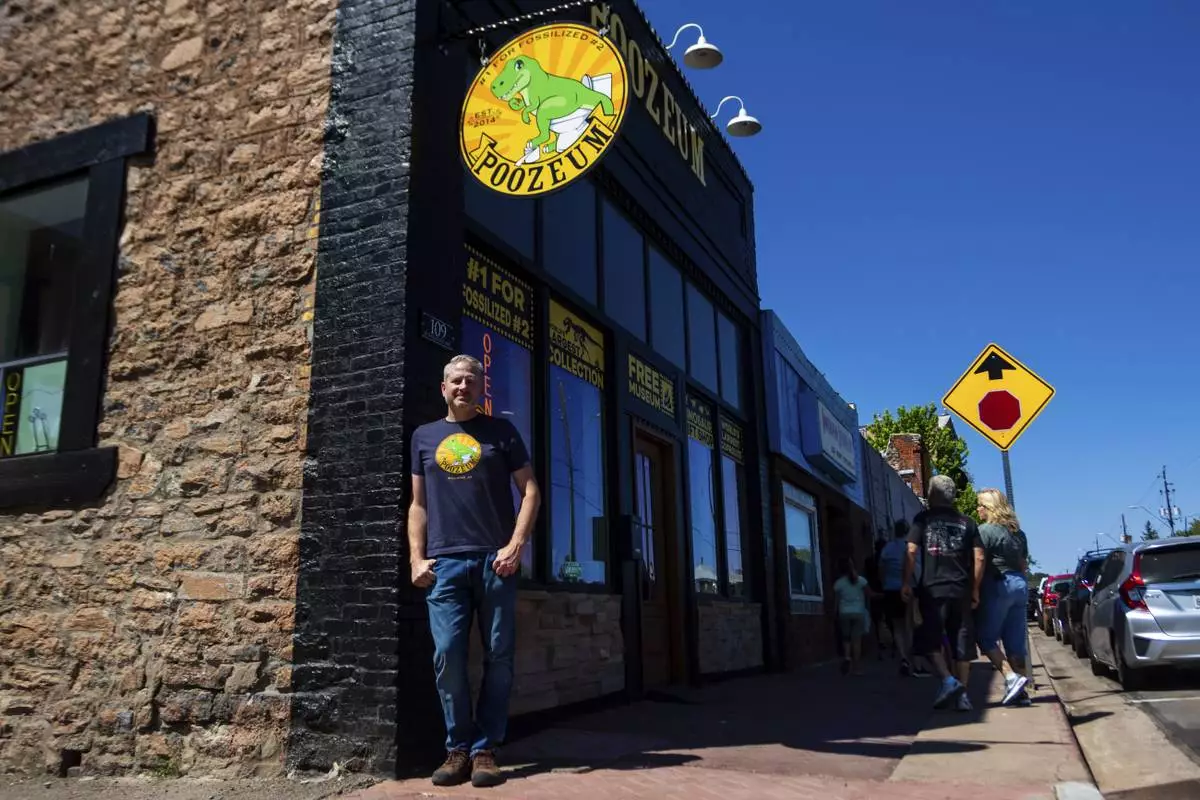
President and curator George Frandsen stands outside his "Poozeum", Friday, June 7, 2024, in Williams, Ariz. The museum in northern Arizona along Route 66 features the fossilized feces of prehistoric animals. Frandsen has been collecting the fossils known as coprolites for nearly three decades. His museum features roughly 7,000 fossils, including one suspected to be from a Tyrannosaurus rex. (AP Photo/Ty ONeil)
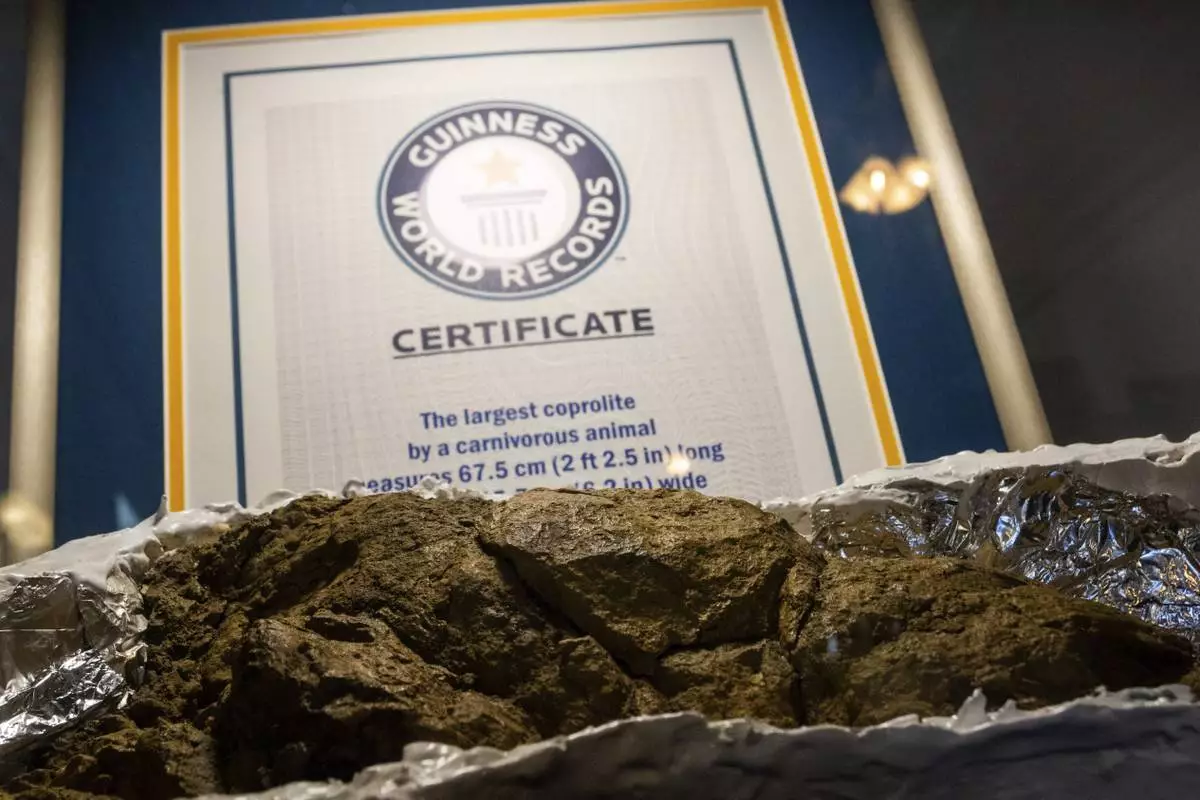
A fossilized coprolite in a casting at the "Poozeum" is shown, Friday, June 7, 2024 in Williams, Ariz. The museum in northern Arizona along Route 66 features the fossilized feces of prehistoric animals. Frandsen has been collecting the fossils known as coprolites for nearly three decades. His museum features roughly 7,000 fossils, including one suspected to be from a Tyrannosaurus rex. Frandsen holds two Guinness Book of World Records titles for parts of his collection. (AP Photo/Ty ONeil)
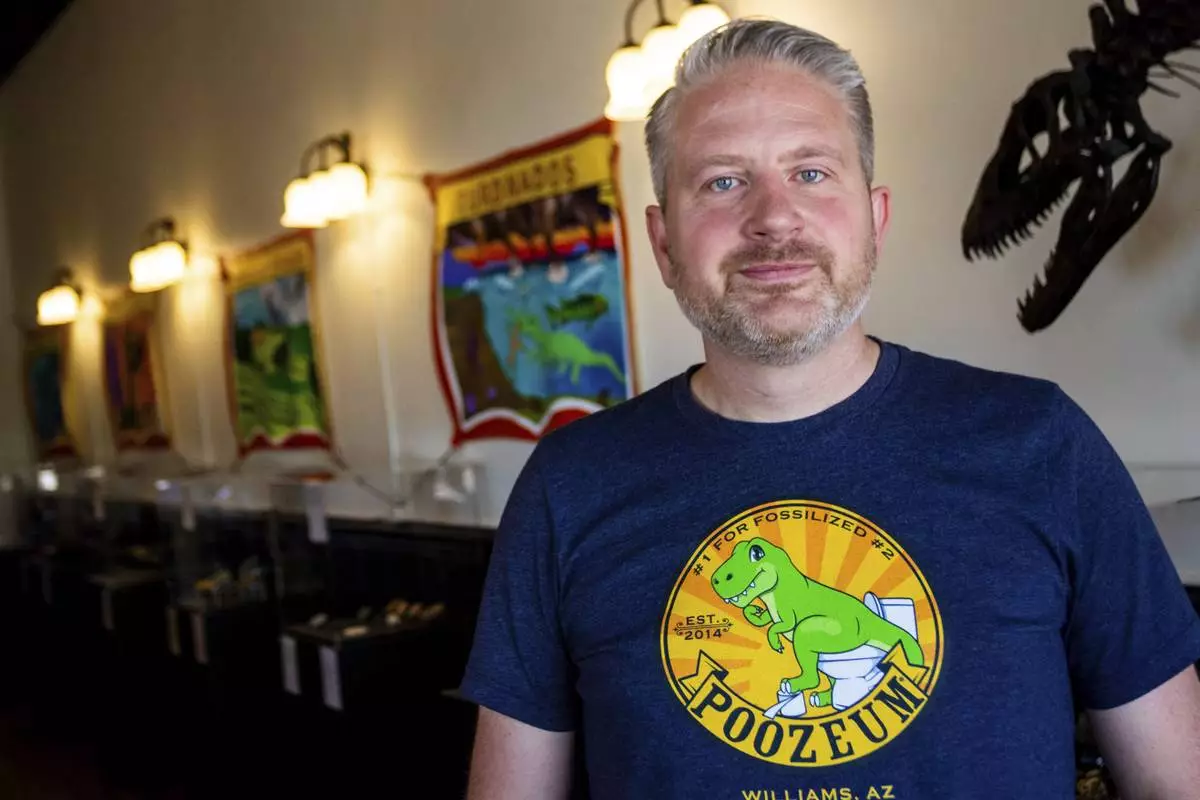
President and curator George Frandsen stands for a photograph inside his "Poozeum", Friday, June 7, 2024 in Williams, Ariz. The museum in northern Arizona along Route 66 features the fossilized feces of prehistoric animals. Frandsen has been collecting the fossils known as coprolites for nearly three decades. His museum features roughly 7,000 fossils, including one suspected to be from a Tyrannosaurus rex. Frandsen holds two Guinness Book of World Records titles for parts of his collection. (AP Photo/Ty ONeil)

President and curator George Frandsen stands for a photograph inside his "Poozeum", Friday, June 7, 2024 in Williams, Ariz. The museum in northern Arizona along Route 66 features the fossilized feces of prehistoric animals. Frandsen has been collecting the fossils known as coprolites for nearly three decades. His museum features roughly 7,000 fossils, including one suspected to be from a Tyrannosaurus rex. (AP Photo/Ty ONeil)

Fossilized crocodilian excrement is displayed at the "Poozeum", Friday, June 7, 2024, in Williams, Ariz. The museum in northern Arizona along Route 66 features the fossilized feces of prehistoric animals. Frandsen has been collecting the fossils known as coprolites for nearly three decades. His museum features roughly 7,000 fossils, including one suspected to be from a Tyrannosaurus rex. (AP Photo/Ty ONeil)
KINGSTON, Jamaica (AP) — Hurricane Beryl was roaring toward Jamaica on Wednesday, with islanders scrambling to make preparations after the powerful Category 4 storm earlier killed at least six people and caused significant damage in the southeast Caribbean.
In Kingston, people boarded up windows, fishermen pulled their boats out of the water before sitting around a table to play dominoes beside a bay, and workers dismantled roadside advertising boards to protect them from the expected lashing winds to come.
A hurricane warning was in effect for Jamaica, Grand Cayman, Little Cayman and Cayman Brac. Beryl was forecast to weaken slightly over the next day or two, but still be at or near major-hurricane strength when it passes near or over Jamaica on Wednesday, near the Cayman Islands on Thursday and into Mexico's Yucatan Peninsula on Friday, according to the U.S. National Hurricane Center.
A hurricane watch was in effect for Haiti's southern coast and the Yucatan’s east coast. Belize issued a tropical storm watch stretching south from its border with Mexico to Belize City.
Late Monday, Beryl became the earliest storm to develop into a Category 5 hurricane in the Atlantic and peaked at winds of 165 mph (270 kph) Tuesday before weakening to a still-destructive Category 4. Early Wednesday, the storm was about 125 miles (200 kilometers) southeast of Kingston. It had maximum sustained winds of 145 mph (230 kph) and was moving west-northwest at 20 mph (31 kph), the center said.
Beryl was expected to bring life-threatening winds and storm surge to Jamaica, where officials warned residents in flood-prone areas to prepare for evacuation.
“I am encouraging all Jamaicans to take the hurricane as a serious threat,” Prime Minister Andrew Holness said in a public address Tuesday. “It is, however, not a time to panic.”
In Miami, U.S. National Hurricane Center Director Michael Brennan said Jamaica appears to be in the direct path of Beryl. He urged residents to find a safe place to shelter and stay there through Wednesday.
“We are most concerned about Jamaica, where we are expecting the core of a major hurricane to pass near or over the island,” he said in an online briefing.
Storm surge of 6-9 feet (1.8 to 2.7 meters) above typical tide levels are likely in Jamaica, as well as heavy rainfall.
A tropical storm warning was in place for the entire southern coast of Hispaniola, an island shared by Haiti and the Dominican Republic.
As Beryl barreled through the Caribbean Sea, rescue crews in southeastern islands fanned out to determine the extent of the damage the hurricane inflicted on Carriacou, an island in Grenada.
Three people were reported killed in Grenada and Carriacou and another in St. Vincent and the Grenadines, officials said. Two other deaths were reported in northern Venezuela, where five people are missing, officials said. About 25,000 people in that area also were affected by heavy rainfall from Beryl.
One fatality in Grenada occurred after a tree fell on a house, Kerryne James, the environment minister, told The Associated Press. She said Carriacou and Petit Martinique sustained the greatest damage, with scores of homes and businesses flattened in Carriacou.
Grenada's prime minister, Dickon Mitchell, said Tuesday there was no power, roads are impassable and the possible rise of the death toll “remains a grim reality.”
St. Vincent and the Grenadines Prime Minister Ralph Gonsalves has promised to rebuild the archipelago. He noted that 90% of homes on Union Island were destroyed, and that “similar levels of devastation” were expected on the islands of Myreau and Canouan.
The last strong hurricane to hit the southeast Caribbean was Hurricane Ivan 20 years ago, which killed dozens of people in Grenada.
Grenada, known as the “spice isle,” is one of the world's top exporters of nutmeg. Mitchell noted that the bulk of the spices are grown in the northern part of the island, which was hit hardest by Beryl.

A man covers the windows of a building to protect it from the incoming Hurricane Beryl in Kingston, Jamaica, Tuesday, July 2, 2024. (AP Photo/Collin Reid)
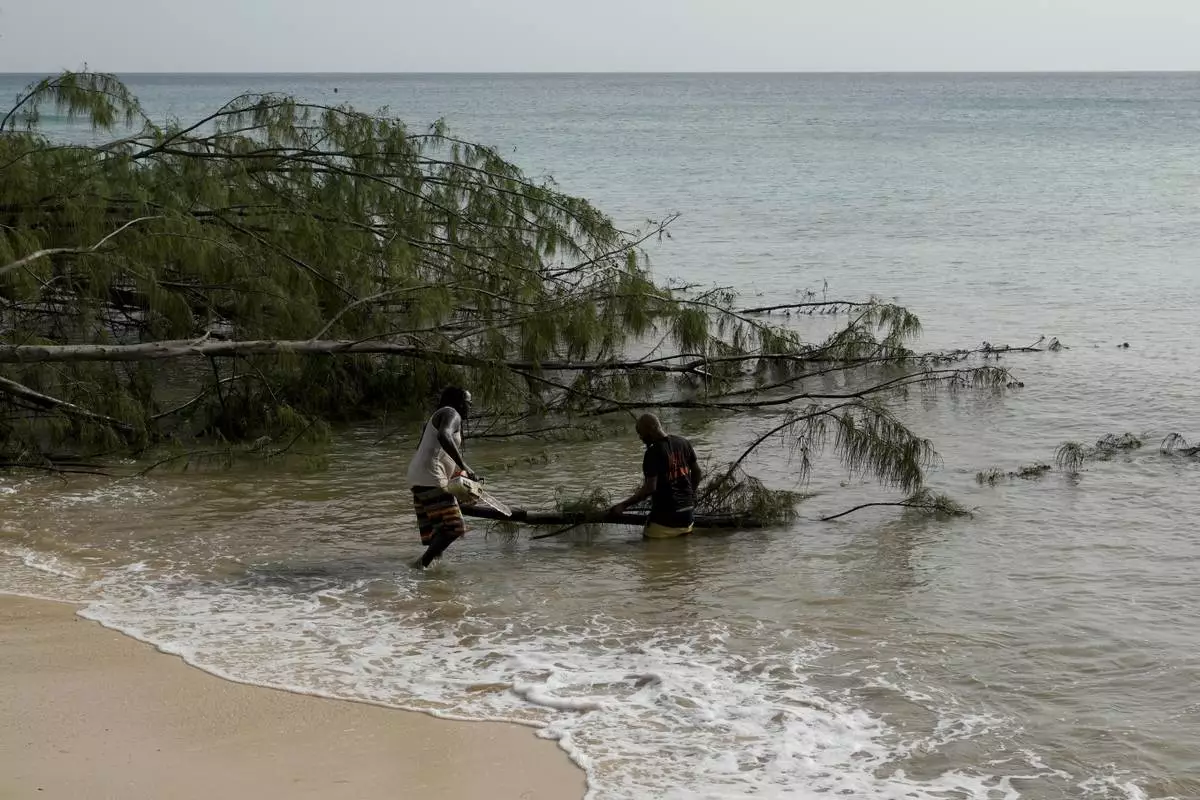
Workers chops a tree uprooted by Hurricane Beryl in St. James, Barbados, Tuesday, July 2, 2024. (AP Photo/Ricardo Mazalan)
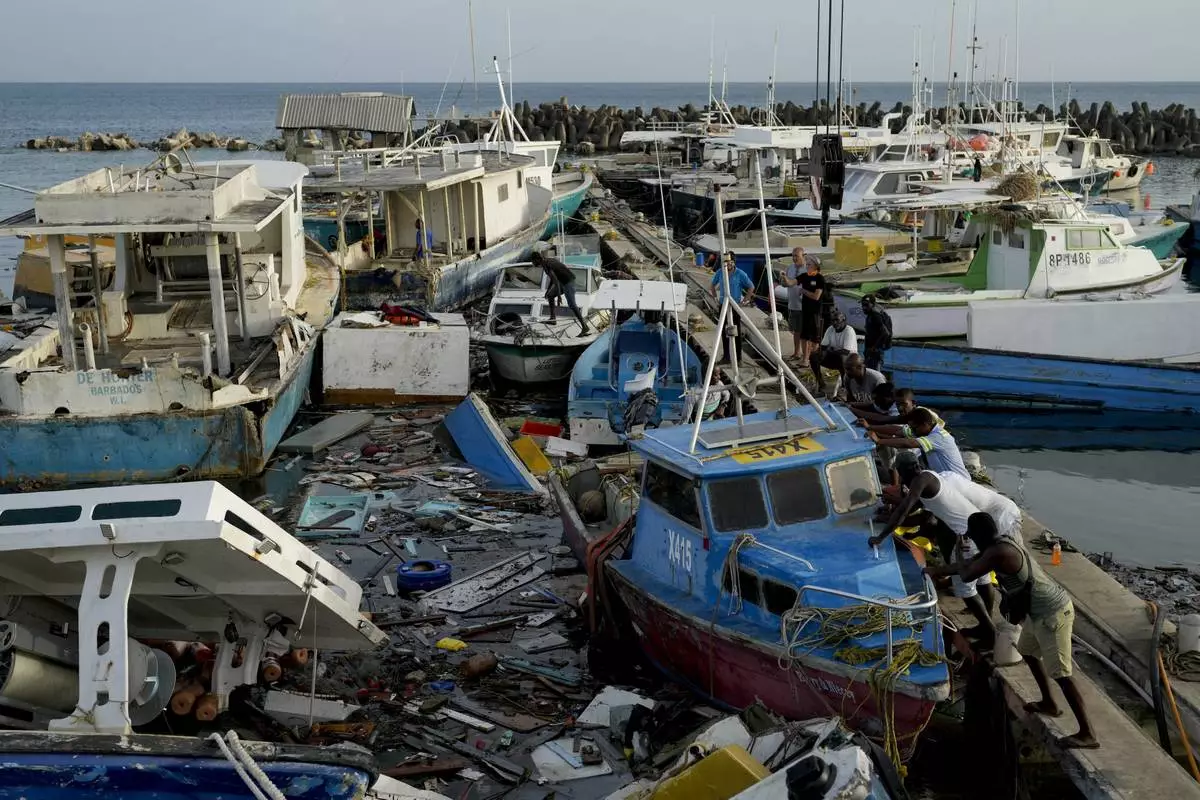
Fishermen push a boat damaged by Hurricane Beryl at the Bridgetown fisheries, Barbados, Tuesday, July 2, 2024. (AP Photo/Ricardo Mazalan)
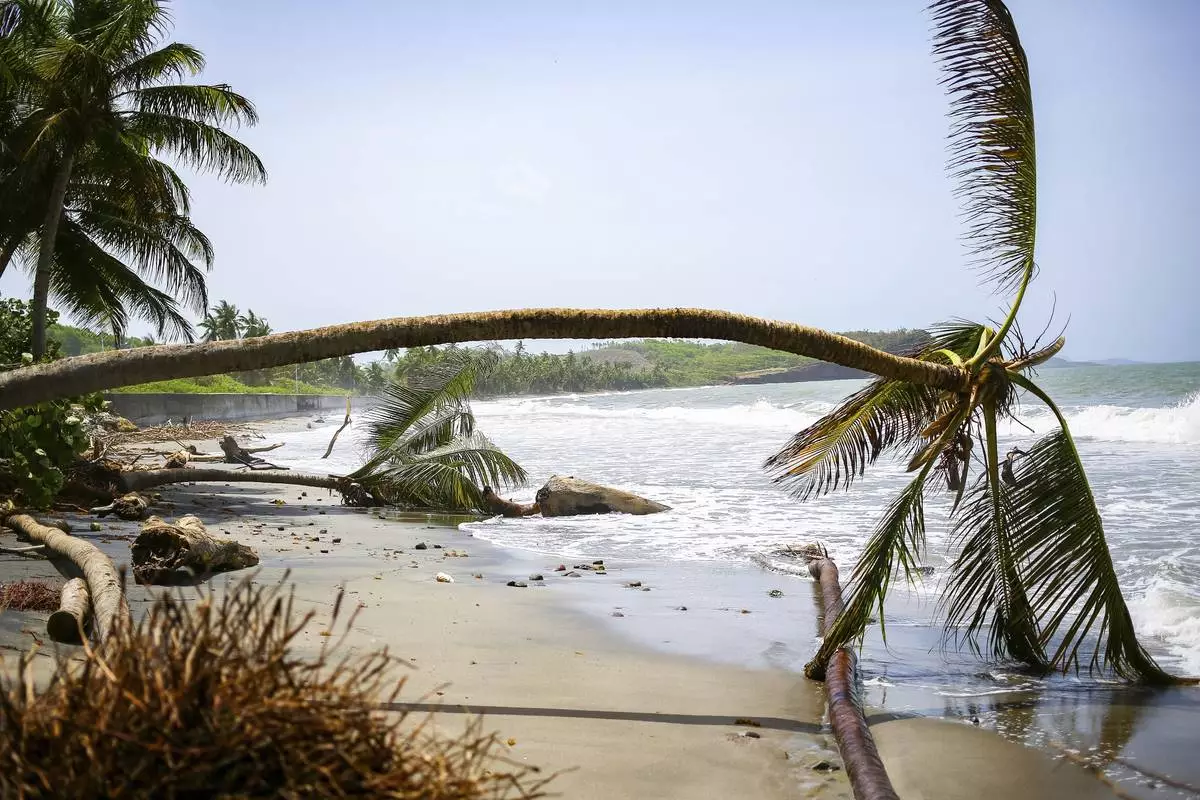
Palm trees wilt after being uprooted by Hurricane Beryl in St. Patrick, Grenada, Tuesday, July 2, 2024. (AP Photo/Haron Forteau)
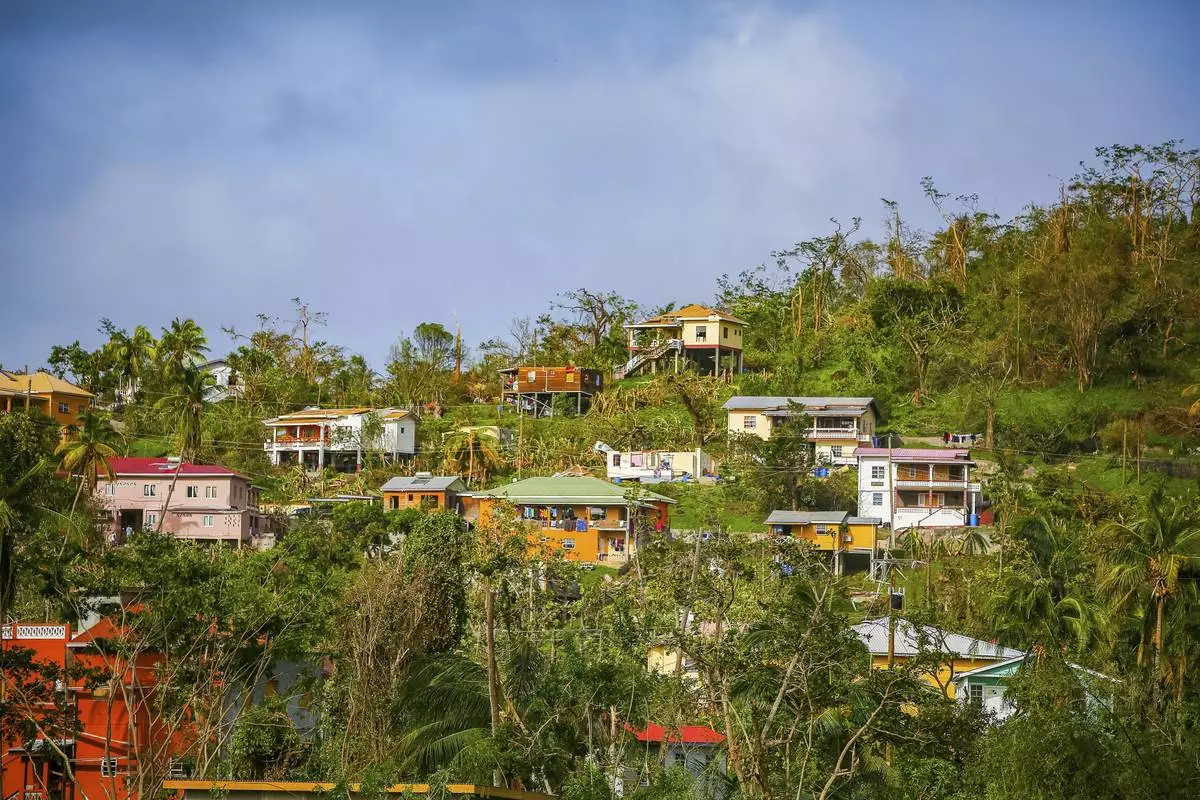
Roofs of houses lie damaged by Hurricane Beryl in St. Patrick, Grenada, Tuesday, July 2, 2024. (AP Photo/Haron Forteau)

Evacuees from Union Island arrive in Kingstown, St. Vincent and the Grenadines, Tuesday, July 2, 2024. The island, in the Grenadines archipelago, was hit by Hurricane Beryl. (AP Photo/Lucanus Ollivierre)
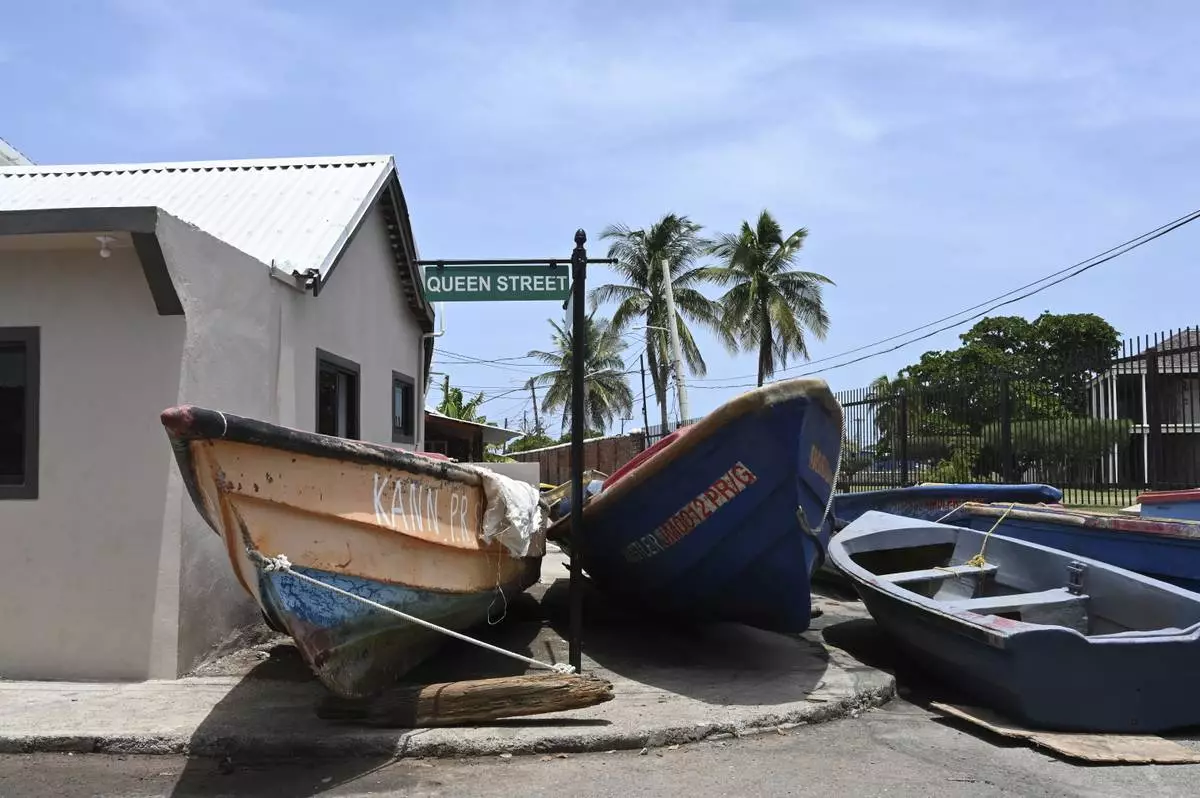
Fishing boats lie in the middle of the street for protection from Hurricane Beryl in Kingston, Jamaica, Tuesday, July 2, 2024. (AP Photo/Collin Reid)
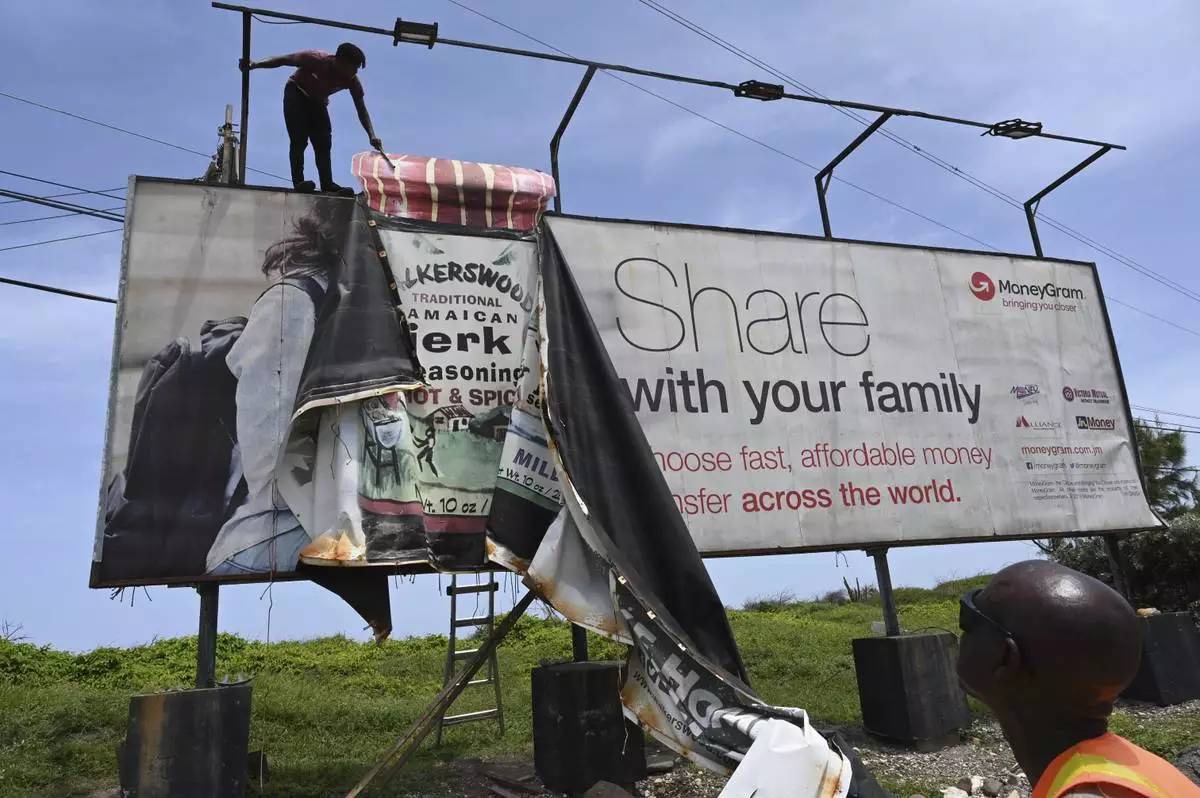
Workers dismantle an advertisement board to protect it from Hurricane Beryl in Kingston, Jamaica, Tuesday, July 2, 2024. (AP Photo/Collin Reid)

Fishermen play dominoes after pulling their boats out of the water to protect them from Hurricane Beryl in Kingston, Jamaica, Tuesday, July 2, 2024. (AP Photo/Collin Reid)







